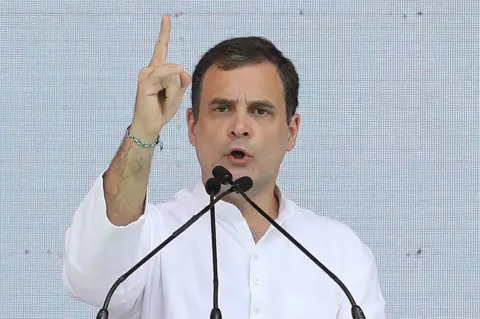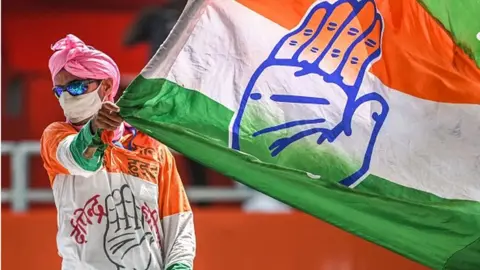Rahul Gandhi: Can long march revive India's Congress party in digital age?
By?
Soutik Biswas
,?
India correspondent

 EPA
EPA
Rahul Gandhi will lead a five-month-long trek through 12 states
On Wednesday, the leader of India's main opposition party will embark on a long march across the country.
Accompanying Rahul Gandhi on the journey to "unite India" will be more than 100 members of his Congress party. It will be a five-month-long, 3,570km (2,218-mile) trek through 12 states. During his journey, Mr Gandhi will meet people in the day and sleep in makeshift accommodation at night. The trek will be livestreamed on a website, and songs will be played relaying its message.
At its heart, the Bharat Jodo Yatra (Unite India March) is political, targeting Prime Minister Narendra Modi's governing Bharatiya Janata Party (BJP). "In many ways, we are engaged in an existential struggle to defend the idea of India enshrined in the Constitution. The message [of the march] is that we are the party that can unite India and stop the process of dividing us on the basis of religion, caste and language that is being promoted by the ruling party," Shashi Tharoor, a senior Congress leader, told me.
The march is equally an attempt at reviving the flagging spirits of an exhausted party and beefing up the sagging image of its leader. "We are going out to listen to people, not to give them lectures," Jairam Ramesh, another party leader, said.
Listening to people is always a good idea. Since 2014, when Mr Modi swept to power in India, the Congress has been in free-fall. It has been routed by the BJP in two successive federal elections, and has lost 40 of 45 state elections. The party now rules in a paltry two states, and is stricken by dissent.
It is unclear what the Congress - which has lost most of its traditional voters to the BJP - stands for, apart from a vision of a secular India. Mr Gandhi himself has often appeared to be a reluctant leader.
Resurrecting the Congress against a fiercely combative and resource-rich opponent like the BJP is not going to be easy. Many believe that a march like this can become the centrepiece of a countrywide movement against the government only if it is led by a popular leader.
There is still no evidence that Mr Gandhi is popular: a new
opinion poll
showed only 9% of the 120,000-odd respondents preferred him as the next prime minister, compared with more than half for Mr Modi. "No public campaign can succeed without its leader having a basic modicum of credibility. In two decades, Rahul Gandhi has repeatedly demonstrated a total lack of connection with the public and has not a shred of credibility left," Baijayant Jay Panda, a national vice-president of BJP, told me.

 AFP
AFP
The Congress party has been in free-fall ever since Mr Modi swept to power in 2014
That's why the party is hoping that the march will help repair Mr Gandhi's image. Zoya Hasan, a political scientist who has written extensively about the Congress, said the long march looked like a bid to "relaunch" him as a national leader. "A focus on uniting people at a time when Indian society is hugely polarised is a compelling message, and should be welcomed by all," she says.
Yet the recent history of long marches in India presents mixed results.
In 1983, opposition leader Chandra Shekhar, embarked on a six-month-long, 4,000km countrywide trek to showcase himself as a grassroots leader. People called the 56-year-old politician the "marathon man". But the march didn't fetch him any political dividends. The next year, the Congress won a landslide riding on a sympathy wave following the assassination of PM Indira Gandhi.
A more significant countrywide trek that changed Indian politics was undertaken by BJP leader LK Advani in 1990. He planned a 10,000km journey in a mini-truck, which looked like a chariot, from the ancient temple town of Somnath in the west to Ayodhya in the north. This was to whip up support for a campaign to build a temple on the site of the Babri mosque in Ayodhya. (Its destruction led to some of the deadliest religious violence in India's history.)
Barely a month after he started, Mr Advani's trip was halted and he was arrested by a political rival, Lalu Prasad Yadav, who ruled in the eastern state of Bihar. Mr Yadav said he had done this to "save humanity". Mr Advani's journey was to become a significant milestone in putting the BJP's agenda of cultural nationalism at the centre of his party's programme.

 Getty Images
Getty Images
BJP leader LK Advani's rally in 1990 was the most politically significant one in recent decades
Mahatma Gandhi's 380km march to the western coast in Gujarat in 1930 to defy British rule remains India's
most historic march
ever. Gandhi, then 61, was hosted, fed and lodged by villagers. He had a pony in tow to carry him in case his body gave up. But the leader walked on, and in the end, the media described the march as "epic and mythic".
Long marches are supposed to be rich in symbolism. Mao's 8,000-mile march with 86,000 Red Army personnel in October 1934, for example, was the founding myth of modern China. Mao had called the march a symbol of endurance to build a new China. But Mr Panda of the BJP said that since "newer modes of messaging have taken over via mass and social media and other types of public gatherings", long marches would only succeed when the leader has "public connect and credibility".
It's difficult to predict whether Rahul Gandhi's long march will revive his party - or become a harbinger of a political change. Mr Tharoor says the "struggle for India's soul will not cease after the march ends". Others like Mahesh Rangarajan, a professor of history and environmental studies at Ashoka University, believe a lot will depend on Mr Gandhi's messaging.

 Getty Images
Getty Images
Janata Party president Chandra Shekhar undertook a six-month-long walk through India in 1983
"What are you rallying them for and against? How does the march put you at the centre of politics?" he asked.
One of the more baffling findings of the latest opinion poll was that Mr Modi's rankings have stayed high despite 35% of respondents saying that their economic condition had deteriorated under his rule. "Look at any metric and the unbelievable popularity of Mr Modi and the trust voters have in him sometimes defies logic,"
noted
Yashwant Deshmukh, the pollster.
Many believe this makes Mr Gandhi's job tougher. "People may be going through a tough time. But do people believe the government is responsible for that? Are they disaffected enough with the ruling party to give another party a chance?" said Prof Rangarajan. Only time will tell whether Mr Gandhi's odyssey succeeds or fails.
Read more India stories from the BBC: